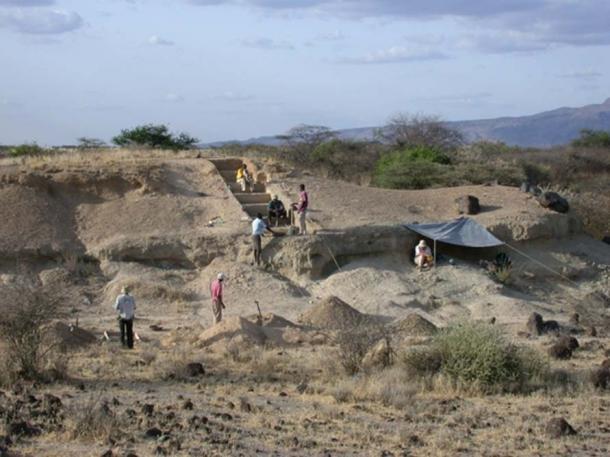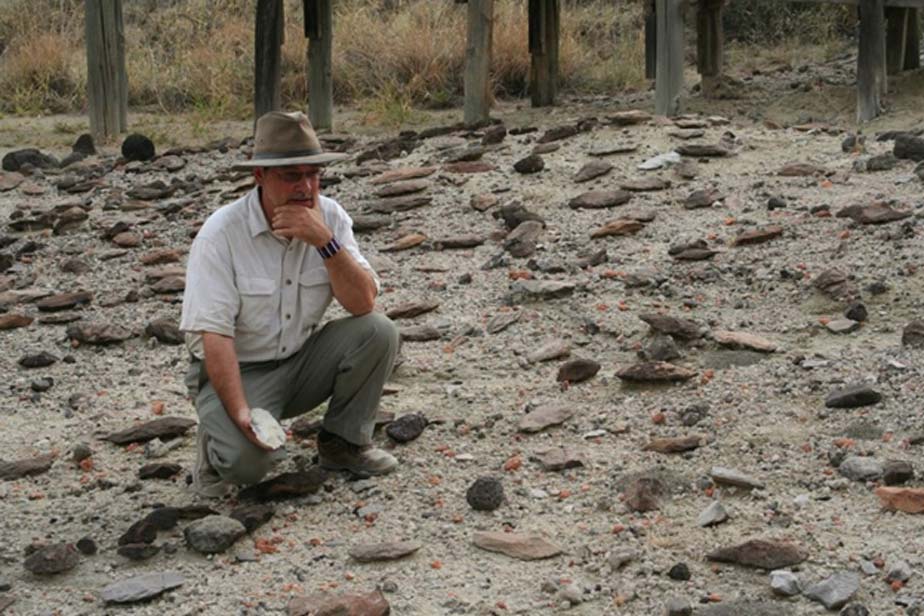New Insights into Rapid Advance in Human Innovative Thinking
The first evidence of human life in the Olorgesailie Basin comes from about 1.2 million years ago. For hundreds of the thousands of years, people living there made and used large stone-cutting tools called handaxes (below left). According to three new studies published in Science, early humans in East Africa had--by about 320,000 years ago--begun using color pigments and manufacturing more sophisticated tools (below right) than those of the Early Stone Age handaxes, tens of thousands of years earlier than previous evidence has shown in eastern Africa. The sophisticated tools (below right) were carefully crafted and more specialized than the large, all-purpose handaxes (below left). Many were points designed to be attached to a shaft and potentially used as projectile weapons, while others were shaped as scrapers or awls. The National Museums of Kenya loaned the artifacts pictured above to conduct the analyses published in Science.

Scientists found hand axes (left) and points (right) that show a clear shift in innovative thinking which occurred 320,000 years ago. (Image: Human Origins Program, Ryan Lavery Smithsonian)
New Date for Innovation Change
Anthropologists at the Smithsonian's National Museum of Natural History and an international team of collaborators have discovered that early humans in East Africa had - by about 320,000 years ago - begun trading with distant groups, using color pigments and manufacturing more sophisticated tools than those of the Early Stone Age. These newly discovered activities approximately date to the oldest known fossil record of Homo sapiens and occur tens of thousands of years earlier than previous evidence has shown in eastern Africa. These behaviors, which are characteristic of humans who lived during the Middle Stone Age, replaced technologies and ways of life that had been in place for hundreds of thousands of years.
- Bigger Brains Led to Bigger Bodies in Our Ancestors
- Why does culture sometimes evolve via sudden bursts of innovation?
Spurred on by Environmental Change
Evidence for these milestones in humans' evolutionary past comes from the Olorgesailie Basin in southern Kenya, which holds an archeological record of early human life spanning more than a million years. The new discoveries, reported in three studies published March 15 in the journal Science, indicate that these behaviors emerged during a period of tremendous environmental variability in the region. As earthquakes remodeled the landscape and climate fluctuated between wet and dry conditions, technological innovation, social exchange networks and early symbolic communication would have helped early humans survive and obtain the resources they needed despite unpredictable conditions, the scientists say.

The Olorgesailie Basin in southern Kenya, which holds an archeological record of early human life spanning more than a million years. (Human Origins Program, Ryan Lavery, Smithsonian)
"This change to a very sophisticated set of behaviors that involved greater mental abilities and more complex social lives may have been the leading edge that distinguished our lineage from other early humans," said Rick Potts, director of the National Museum of Natural History's Human Origins Program.
Potts has been leading the Human Origin Program's research in Olorgesailie for more than 30 years in collaboration with the National Museums of Kenya. He is the lead author on one of the three Science publications that describe the adaptive challenges that early humans faced during this phase of evolution. Alison Brooks, a professor of anthropology at George Washington University's Center for the Advanced Study of Human Paleobiology and an associate of the museum's Human Origins Program, is lead author on the paper that focuses on the evidence of early resource exchange and use of coloring materials in the Olorgesailie Basin. A third paper, by Alan Deino at the Berkeley Geochronology Center and colleagues, details the chronology of the Middle Stone Age discoveries.
- 3.3-million-year-old stone tools overturn archaeological record, predate early humans
- Oldest Tools in the World Found at Lake Turkana, Predate Early Humans
Toolmaking Shift
The first evidence of human life in the Olorgesailie Basin comes from about 1.2 million years ago. For hundreds of the thousands of years, people living there made and used large stone-cutting tools called handaxes. Beginning in 2002, Potts, Brooks and their team discovered a variety of smaller, more carefully shaped tools in the Olorgesailie Basin. Isotopic dating by Deino and collaborators revealed that the tools were surprisingly old - made between 320,000 and 305,000 years ago. These tools were carefully crafted and more specialized than the large, all-purpose handaxes. Many were points designed to be attached to a shaft and potentially used as projectile weapons, while others were shaped as scrapers or awls.

The Smithsonian team found small stone refit points and base core (above) made of non-local obsidian at their Middle Stone Age sites. (Image: Human Origins Program, Ryan Lavery Smithsonian)
Material Sourcing
While the handaxes of the earlier era were manufactured using local stones, the Smithsonian team found small stone points made of non-local obsidian at their Middle Stone Age sites. The team also found larger, unshaped pieces of the sharp-edged volcanic stone at Olorgesailie, which has no obsidian source of its own. The diverse chemical composition of the artifacts matches that of a wide range of obsidian sources in multiple directions 15 to 55 miles away, suggesting exchange networks were in place to move the valuable stone across the ancient landscape.
The team also discovered black and red rocks - manganese and ocher - at the sites, along with evidence that the rocks had been processed for use as coloring material. "We don't know what the coloring was used on, but coloring is often taken by archeologists as the root of complex symbolic communication," Potts said. "Just as color is used today in clothing or flags to express identity, these pigments may have helped people communicate membership in alliances and maintain ties with distant groups."
- Paleolithic weapons factory was a rich source of obsidian tools from 1.4 million years ago
- Female Chimps and Tools

Stone tools and pigment. (Image: Human Origins Program, Ryan Lavery, Smithsonian)
Changing the Human Landscape
Hoping to understand what might have driven such fundamental changes in human behavior, the research team integrated data from a variety of sources to assess and reconstruct the ancient environment in which the users of these artifacts lived. Their findings suggest that the period when these behaviors emerged was one of changing landscapes and climate, in which the availability of resources would have been unreliable.
Geological, geochemical, paleobotanical and faunal evidence indicates that an extended period of climate instability affected the region beginning around 360,000 years ago, at the same time earthquakes were continually altering the landscape. Although some researchers have proposed that early humans evolved gradually in response to an arid environment, Potts says his team's findings support an alternative idea. Environmental fluctuations would have presented significant challenges to inhabitants of the Olorgesailie Basin, prompting changes in technology and social structures that improved the likelihood of securing resources during times of scarcity.

Excavations at the Olorgesailie site. (Image: Human Origins Program, Ryan Lavery Smithsonian)
The research teams for the three studies published in Science include collaborators from the following institutions: the Smithsonian Institution, the National Museums of Kenya, George Washington University, the Berkeley Geochronology Center, the National Science Foundation, the University of Illinois at Urbana-Champaign, the University of Missouri, the University of Bordeaux (Centre National de la Recherche Scientifique), the University of Utah, Harvard University, Santa Monica College, the University of Michigan, the University of Connecticut, Emory University, the University of Bergen, Hong Kong Baptist University and the University of Saskatchewan.
Funding for this research was provided by the Smithsonian, the National Science Foundation and George Washington University.
Top image: Rick Potts, director of the National Museum of Natural History’s Human Origins Program at the Smithsonian, surveys an assortment of Early Stone Age hand-axes discovered in the Olorgesailie Basin, Kenya. Source: Smithsonian
The article, originally titled ‘Scientists discover evidence of early human innovation, pushing back evolutionary timeline,’ was originally published on Science Daily.
Source: Smithsonian. "Scientists discover evidence of early human innovation, pushing back evolutionary timeline: Evidence of innovation dates to a period when humans faced an unpredictable and uncertain environment, according to three new studies." ScienceDaily. ScienceDaily, 15 March 2018. <www.sciencedaily.com/releases/2018/03/180315140733.htm>.
Reference:
Richard Potts, Anna K. Behrensmeyer, J. Tyler Faith, Christian A. Tryon, Alison S. Brooks, John E. Yellen, Alan L. Deino, Rahab Kinyanjui, Jennifer B. Clark, Catherine Haradon, Naomi E. Levin, Hanneke J. M. Meijer, Elizabeth G. Veatch, R. Bernhart Owen, Robin W. Renaut. Environmental dynamics during the onset of the Middle Stone Age in eastern Africa. Science, 2018 DOI: 10.1126/science.aao2200




















Comments
RE: "East Africa had--by about 320,000 years ago--begun using color pigments and manufacturing more sophisticated tools (below right) than those of the Early Stone Age handaxes"
I am the eye witness. I have spent months in Tanzania (Mt Kilimanjaro, Ngorongoro, Tarangeti, Serengeti, Oldupai, Stonetown, Arusha, Dar Es Salaam) and southern Kenya, I CAN attest this - people's from India have ruled, enslaved, taxed, employed the peoples of East Africa. Look for evidence of evolution of intelligence in the masters.
From personal experience, I saw peoples content in men begging alongside highways (built by Japanese, Portuguese, Dutch tourism companies) chatteling women and women tending flocks, gathering firewood and collecting water. My last excursion 6 years ago revealed no material change in "cities" more like slums, and culture than the first trip 20 years ago.
Provided the native tribes developed in intellect rapidly after eons in this diatribe, the advancements today come from outside influences and NOT the locals.
FACTS are facts. Question me.